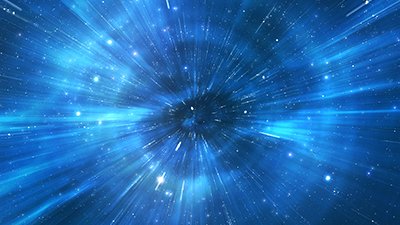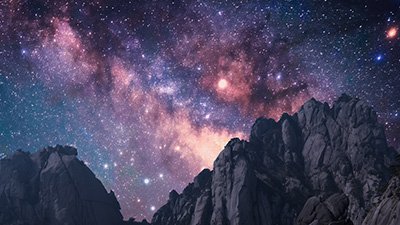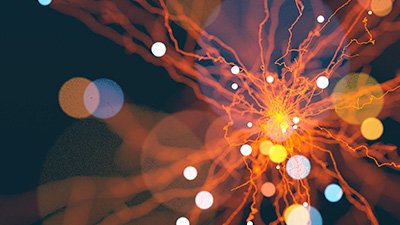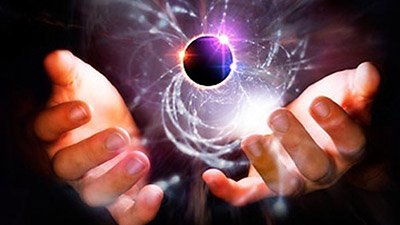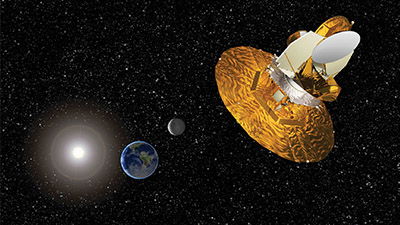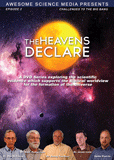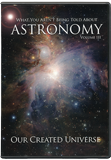Big Bang
What is the big bang? Did God use the big bang to create the universe? Discover the history of big bang thought and scientific problems with the big bang.
The big bang is a naturalistic story about the origin and development of the universe (e.g. a cosmology), beginning with a “singularity” when all mass, energy, and space was contained in a much smaller volume than the universe today. It is riddled with problems, supported by numerous unobserved assumptions, and, most importantly, contradicts the biblical teaching of creation.
How did our universe come into existence? Did it come about entirely by natural means? Was it created by God, and if so, how did he do it? Did God start the clock ticking and then use natural methods to allow the universe to mature over billions of years, or did he create everything supernaturally finishing the heavens and celestial objects by the first four days of creation week? These questions are central to our understanding of the purpose of the universe and our significance within it.
Contents
- Did God Use the Big Bang to Create the Universe?
- How the Big Bang Became the Dominant View
- Problem with Big Bang: Missing Monopoles
- Problem with Big Bang: Too Little Antimatter
- Problem with Big Bang: No Population III Stars
- Problem with Big Bang: No Evidence for Cosmic Inflation
- Problem with Big Bang: The Axis of Evil and the Cold Spot
- Conclusion: The Big Bang Proposition Is Not Good Science
Did God Use the Big Bang to Create the Universe?
Some Christians accept the claim that God used naturalistic processes, including the big bang, to create the universe. They would agree with secular (and mostly atheistic) astronomers that the stars and planets formed by slow natural processes over billions of years—with only one exception, that God’s hand directed these processes. Unfortunately, such views deny what the Creator Himself has said about the creation of the universe.
The big bang is diametrically opposed to the supernatural creation described in the Bible. Furthermore, there are many other differences between the big bang and the biblical account of origins. For example,
- The Bible tells us that God created heaven, earth, and everything within them in the span of six days (Exodus 20:11) and rested on the seventh day. This is the basis for our work week (Exodus 20:8). In contrast, the big bang model claims that the universe and earth formed over billions of years.
- Genesis tells us that God created the stars on the fourth day—three days after the earth was created. In contrast, the big bang model claims that stars existed billions of years before the earth.
- The Bible tells us that the earth was made from water (2 Peter 3:5; Genesis 1:2–9; Psalm 24:2), but the standard secular model teaches that the earth began as a molten planet which cooled over millions of years, and that the oceans were the result of asteroid or meteor impacts, or from dissolution of comets as they entered earth’s atmosphere.
How the Big Bang Became the Dominant View
How did the big bang become the dominant secular model of cosmology?
The big bang model predicted that the universe ought to be filled with radiation in the microwave part of the spectrum having a temperature of only a few Kelvin (K). This radiation, referred to as the Cosmic Microwave Background, supposedly comes from a time a few hundred thousand years after the big bang. When the Cosmic Microwave Background (often abbreviated CMB or CBR) was then discovered in 1964, and which was now a successful prediction of the big bang. Other cosmologies like the steady state model fell out of favor and the big bang assumed the position as the most popular of the naturalistic cosmologies. Ironically, it was a staunch opponent (and steady state proponent) of the Cosmic Egg hypothesis, who gave it the name we use today. Sir Frederick Hoyle mockingly nicknamed it the big bang and the name stuck.
As it turns out the CMB was the one successful prediction of the big bang model, but there are many problems with it. But for every problem that crops up, a new addition to the model is proposed which rescues the paradigm. But there is no proof for any of these rescuing devices; and no real empirical data to refute the following problems with the big bang.

Problem with Big Bang: Missing Monopoles
There are several scientific problems with the big bang theory. For one, we are missing monopoles.
A “monopole” is a hypothetical massive particle that is just like a magnet but with only one pole. So a monopole would have either a “north” pole or a “south” pole, but not both. Particle physicists claim that the high temperature conditions of the big bang should have created magnetic monopoles.
Since monopoles are predicted to be stable, they should have lasted to this day. Yet, despite considerable searching, monopoles have not been found. The fact that we don’t find any monopoles strongly suggests that the universe never was that hot. This indicates that there never was a big bang. But the lack of monopoles is not problematic for the Bible’s account of creation because the universe did not start at extremely high temperatures.
Problem with Big Bang: Too Little Antimatter
A second scientific problem with the big bang is there is too little antimatter.
The big bang model proposes that matter (hydrogen and helium gas) was created from energy as the universe expanded. However, experimental physics tells us that whenever matter is created from energy, such a reaction also produces antimatter. Antimatter has similar properties to matter, except the charges of the particles are reversed.
The big bang should have produced equal amounts of matter and antimatter. Thus, if the big bang were true, there should be an equal amount of matter and antimatter in the universe today. But there is not. The visible universe is comprised almost entirely of matter—with only trace amounts of antimatter.

Problem with Big Bang: No Population III Stars
A third scientific problem with big bang cosmology is there are no ‘population III’ stars.
The big bang model by itself can account for the existence of only the three lightest elements (hydrogen, helium, and trace amounts of lithium). This leaves the other naturally occurring elements unexplained. Since the conditions in the big bang model are not right to form these heavier elements, secular astronomers believe that stars have produced the remaining elements by nuclear fusion in their cores, which then distribute the heavier elements into space when they exploded (went supernovae).
Second- and third-generation stars are thus “contaminated” with small amounts of these heavier elements. If this were true, then the first stars would be comprised of only the three lightest elements (since these would have been the only elements in existence initially). Some such stars should still be around today since their lifespans are supposed to exceed the 13.8 billion years that has elapsed since the big bang. Such stars would be called “population III” stars. Amazingly population III stars have not been found anywhere. All known stars have at least trace amounts of heavy elements in them.
Problem with Big Bang: No Evidence for Cosmic Inflation
A fourth scientific problem with the big bang is there is no evidence for cosmic inflation.
According to the big bang model, the universe suddenly appeared 13.8 billion years ago in a very dense, hot state that expanded into the universe that we see today. But cosmologists realized that there were problems with the CMB. One of these was the horizon problem: the CMB observed from opposite parts of the sky had precisely the same temperature. But how could that be?
Those positions opposite one another had never had a chance to exchange heat, so how could they have come into thermal equilibrium. A theoretical physicist named Alan Guth suggested cosmic inflation to solve the horizon problem. According to the theory of cosmic inflation, 10-34 seconds after the big bang the universe briefly and rapidly expanded, or inflated, to a much larger size with a velocity far faster than the speed of light. This would allow the entire universe initially to be in thermal contact so that it could come into the thermal equilibrium before being pulled out of thermal equilibrium by inflation. The only problem with inflation? There’s absolutely no evidence for it, and attempted “proofs” have been proposed and then bit the dust.

Problem with Big Bang: Axis of Evil and the Cold Spot
A fifth scientific problem with the big bang is the twofold “hot and cold problem” with certain regions of the CMB. The Axis of Evil is a large region of the mapped CMB that has hotter than expected temperatures (below the ecliptic plane) than the Big Bang would allow for. The Cold Spot is a smaller circular region which has colder than expected temperatures. Both were first detected by the WMAP (Wilkinson Microwave Anisotropy Probe) launched in 2001. Rather than confront the problems, scientists ascribed it to lack of precise data and hoped they would go away.
But in 2009 the Planck probe was launched and has provided the most detailed data on the CMB to date. Both the Axis of Evil and the Cold Spot were still there in the data. There are two major problems with the axis of evil. The axis of evil extends over too large an area to be due to primordial density differences. There are many properties of the CMB that the big bang model can account for, such as a slightly warmer and cooler directions in space that are diametrically opposite. However, there is no known effect that can explain the axis of evil. Second, the axis of evil aligns with the plane in which the earth and the other planets orbit the sun. If the CMB truly is cosmological, this makes no sense—why would some huge structure in the universe align with the plane of the solar system? This alignment to the plane of the solar system suggests that the axis of evil is locally generated rather than cosmically generated.
The cold spot is about 10 degrees in diameter, and it has an average temperature of 70 μK (0.00007 K). In contrast, the temperature fluctuations attributed to density variations in the early universe extend over much smaller parts of the sky and typically differ by only 18 μK from the average CMB temperature. Furthermore, some portions of the cold spot are 140 μK cooler than the average CMB temperature. Not only that, but the Cold Spot is below the ecliptic plane, which typically has higher temperatures than areas above the ecliptic plane. This result is puzzling to cosmologists. There have been several proposed explanations for the cold spot. One suggestion is that it is the result of a supervoid in direction of the cold spot. A more fanciful proposal is that this is the signature of another universe that left its imprint on our universe during cosmic inflation that hypothetically happened shortly after the big bang. But most cosmologists seem to be content to ignore the cold spot too.
Conclusion: The Big Bang Proposition Is Not Good Science
The above examples are just a few of the many problems with the big bang model. There simply isn’t any good reason to believe in the big bang. It is not compatible with the Bible, and it’s not good science. Any scientific model which must be propped up continually with unverifiable hypotheses is not falsifiable and therefore not science—in fact it’s blind faith. We have a reasoned faith which is based on a trustworthy and reliable Witness, who has told us the origins of the universe in his revealed Word of the Bible.
News About Big Bang
-
Dec. 11, 2023 from Ken Ham Blog
How did the universe begin? The explanation of a new hypothesis of “two Big Bangs” reads exactly like fiction—because it is!
-
Aug. 10, 2023 from Ken Ham Blog
It’s the biblical worldview that explains what we see around us, not the big bang or evolution.
-
April 12, 2018 from Ken Ham Blog
“Our universe may end the same way it was created: with a big, sudden bang.” This is the opening line of a recent article on Business Insider.
Articles About Big Bang
-
Jan. 29, 2022 from The New Answers Book 2
The “big bang” story aims to explain the universe’s origin without God and simultaneously fails to align with either the Bible & established scientific findings.
-
Dec. 4, 2021 from Answers in Depth
The big bang has been the dominant cosmogony for more than a half century, but the lithium measurements in the universe do not match the model.
-
Oct. 20, 2018 from Answers in Depth
It’s ironic that the very thing that supposedly is the proof of the big bang model may turn out to be its undoing.
-
Magazine Department ArticleBig Bang BackpedalingJuly 1, 2015 from Answers Magazine
The big bang model relies on a hypothetical event known as cosmic inflation.
-
Semi-Technical In-Depth ArticleBig Bang Cosmology Challenged by Dust and a Massive Black HoleMarch 7, 2015 from Answers in Depth
Will studies revealing a quasar with a much-too-massive black hole and a galaxy with young space dust lead to the downfall of the big bang model?
-
Semi-Technical In-Depth ArticleStudy Says Universe Had No Beginning and No Big Bang?Feb. 19, 2015 from Answers in Depth
A study suggests the universe had neither a beginning nor a big bang, but if the universe is eternal, then there is no need of God.
-
Technical In-Depth ArticleQuantum Fluctuations May Kill Big Bang EvangelismFeb. 12, 2015 from Answers in Depth
Many Christians today embrace the big bang theory as an avenue for evangelism, but if big bang evangelism ever was effective, its window is rapidly closing.
-
Technical In-Depth ArticleThe Primordial Lithium ProblemJan. 15, 2015 from Answers in Depth
Rather than providing good evidence for the big bang model, the abundances of the light elements represents a significant problem for the standard cosmology.
-
A Big BeliefAug. 18, 2014 from Answers Update
Both the cosmic microwave background and the big bang model are fraught with problems.
-
Magazine Department ArticleInflated ClaimsJuly 1, 2014 from Answers Magazine
Astronomers claim they finally have tangible proof of the big bang, thanks in part to a radio telescope in Antarctica that detected gravitational waves.
-
Magazine Department ArticleBig Bang and Evolution Still a Big Question . . .July 1, 2014 from Answers Magazine
Statistics from an AP poll conducted in March 2014
-
In-Depth Article“Fossil Galaxy” Said to Show Conditions Soon After the Big BangMay 17, 2014 from Answers in Depth
Are the chemical signatures in a faint galaxy the fossil remnants of our universe’s birth?
-
Semi-Technical Magazine ArticleBig Bang—The Evolution of a TheoryApril 1, 2014 from Answers Magazine
The big bang model has proven to be quite pliable, morphing to adapt to each new problem. Are these changes true improvements or rescuing devices?
-
Book ChapterNon-Biblical Alternatives to the Big BangJune 18, 2013 from Universe by Design
What are the alternatives to the big bang, and how pervasive is the belief in the big bang?
-
Book ChapterProblems with the Big BangJune 11, 2013 from Universe by Design
In this chapter we shall explore some of the difficulties that modern cosmology and the big bang have.
-
Planck Map Confirms Big Bang Model Just Doesn’t FitMarch 30, 2013 from News to Know
Planck map increases age estimate of the universe but confirms a plank of the big bang model just doesn’t fit.
-
Sky Survey Discovers Big Bang-defying Quasar ClusterJan. 19, 2013 from News to Know
Sky Survey discovers a faraway quasar cluster that is too big to exist within the big bang model’s assumptions.
-
Physics Theories to Explain Big BangSept. 29, 2012 from News to Know
Cosmologist asserts physics theories will explain the big bang without a “supernatural jumpstart.”
-
Book ChapterThe Big-Bang God or the God of Scripture?April 5, 2012 from Old-Earth Creationism on Trial
Some people have suggested that God (or a god) used a “big bang” to create the universe.
-
Astronomers Discover Clouds of “Primordial” GasNov. 19, 2011 from News to Know
Does pristine “primordial” gas prove the big bang happened?
-
-
Vatican Backs the Big Bang TheoryJan. 8, 2011 from News to Know
Based on the press reports, the Roman Catholic Church continues to accept the big bang model of universal origins, but the pope makes it clear that believers should still see a divine mind behind the bang.
-
Book ChapterThe Big Bang?Dec. 23, 2010 from Evolution Exposed: Earth Science
Many people believe that the big bang is compatible with the biblical account of Creation. However, in order to make the big bang fit into the Bible, the biblical explanation is rearranged.
-
Rejecting Big Bang as FactJuly 31, 2010
Is the big bang a scientific “fact” rejected only by young-earth creationists? A new physics paper shows otherwise.
-
Look to Genesis for Questions of “Why?”June 5, 2010
“[W]e exist, and [secular] physicists (among others) would dearly like to know why.” Of course, all they have to do is open to Genesis!
-
Semi-Technical In-Depth ArticleFrom the Depths of SpaceJuly 15, 2009 from Answers in Depth
The discovery of the farthest known space object points out some of the problems with the big bang—and why we can trust Genesis.
PDF Download -
Magazine Department ArticleAre You Really Reading This?July 1, 2008 from Answers Magazine
The big bang theory refutes itself.
-
Physicists Claim They Can Detect the Time Before the Big BangJune 14, 2008
Physicists in the U.S. have claimed we may be able to detect time before time: what existed before the fabled big bang.
-
Semi-Technical Feedback ArticleIs the Big Bang an Attempt to Remove God?March 7, 2008 from Feedback
A reader questions our claim that the big bang is an attempt to explain the universe without God. Dr. Jason Lisle, AiG–U.S., responds.
-
Magazine Department ArticleA Billion Problems with the Big BangJan. 1, 2008 from Answers Magazine
The big bang model not only contradicts Scripture, but astronomers keep finding other problems.
-
Nov. 20, 2007 from Answers Magazine
How did this universe come into existence? Did God use “natural” methods to create the universe, or did He create everything supernaturally?
-
Scientists Found Nothing, DelightedSept. 1, 2007
News flash: nothing has been found in the universe, reports a University of Minnesota team of astronomers—or, at least, that they have found an “enormous void” in space with nothing in it.
-
Too Big for the Big Bang?Aug. 18, 2007 from News to Know
Astronomers looking at galaxies far, far away have found five that don’t quite fit big-bang ideas.
-
The Big Bang—A HypothesisMay 31, 2007 from Responding to Protestors’ Propaganda
The big bang is not an observable event that scientists can duplicate in the lab. It is a hypothesis about how the universe came to be.
-
Magazine Department ArticleA Not-So-Nobel EffortApril 1, 2007 from Answers Magazine
Scientists George Smoot and John Mather were acknowledged for “work that helped cement the big-bang theory of the universe and deepen understanding of the origin of galaxies and stars.”
-
Nov. 27, 2006 from Answers Magazine
As the press extensively reported last spring, evidence for inflation in the universe has been found, supposedly providing a firmer foundation for the big bang theory
-
A Nobel Notion?Oct. 6, 2006
The big bang model still does not answer the fundamental questions of where the original matter came from or what caused it to begin expanding.
-
A "New" Big Bang (Theory)Aug. 26, 2006
A few scientists, most prominently Cambridge’s Neil Turok and Princeton’s Paul Steinhardt, have proposed a “revolutionary model of how the universe began,” which is angering traditional advocates of big bang model.
-
Have Cosmologists Discovered Evidence of Inflation?March 29, 2006
It appears that the claim that we have found evidence of inflation is overstated. At best, the evidence is very indirect and to the point of being premature.
-
The Big Bang and Evidence for the “Inflation Theory”—A Preliminary CommentMarch 23, 2006
The news media has been abuzz recently about supposed evidence that the universe expanded rapidly, growing to billions of light years across—all within the first trillionth of a second after its birth
-
“Ripples” of Galaxies—Another Blow to the Big BangFeb. 16, 2005
Astronomers have recently claimed to detect a “ripple” pattern in the clustering of galaxies in the Sloan Digital Sky Survey.
-
Magazine ArticleYoung Galaxies Too Old for the Big BangJune 1, 2004
This discovery is a huge problem for evolutionary timescales. These galaxies exist when, according to big bang cosmology, they shouldn’t have had time to form.
-
Feedback ArticleA “More Glorious” Means for Creation?Nov. 14, 2003 from Feedback
A Christian who is a scientist wrote AiG expressing a view that the big bang and evolution glorify God more than creating in six literal days.
Recommended Resources

Answers in Genesis is an apologetics ministry, dedicated to helping Christians defend their faith and proclaim the good news of Jesus Christ.
- Customer Service 800.778.3390
- Available Monday–Friday | 9 AM–5 PM ET
- © 2026 Answers in Genesis



